E.G. Lewis's Blog, page 5
May 9, 2012
ROMAN MERCHANT SHIPS — WARHORSES of the ANCIENT WORLD
 Divers Gather Amphorae from a Shipwreck
Divers Gather Amphorae from a ShipwreckHello My Friend and Welcome.
At its peak, the Roman Empire completely encircled the Mediterranean Sea, which First Century Romans conveniently called Mare Nostrum, or Our Sea. Not only did its waters provide fish to feed citizens from Mauritania to Hispania, it also facilitated inter-Empire trade between the various Provinces. Rome had a vigorous, far-flung, and diverse trade network that extended far beyond their borders to India and China.
ROME’S MERCHANT MARINERoman merchants moved all sorts of goods and foodstuffs by sea. Commercial vessels were known by a variety of names, such as corbita, gaulus, ponto, or cladivata, depending upon the region. Overall, the ships demonstrated great uniformity in design. This would be expected given the level of maritime commerce within the Empire. Innovations and improvements were quickly shared and disseminated within the industry.
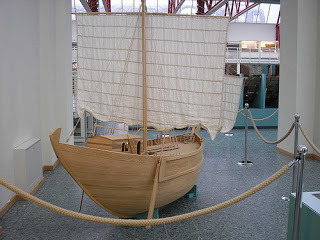 Museum Reproduction of a Roman Corbita
Museum Reproduction of a Roman CorbitaLEARNING FROM DISASTEROur knowledge of Roman shipping comes from two sources, ancient drawings and illustrations, and shipwrecks. The large number of shipwrecks found around the Mediterranean illustrates not only the quantity of shipping that took place, but the perils of traveling by sea in earlier times. We can verify this based on the detailed account in Acts of the Apostles of Paul being shipwrecked on his way to Rome. Depending on size and intended use of the ship, the hull shape could be either symmetrical or asymmetrical. In the first case the stern and bow were essentially identical. In the asymmetric version, the bow was located at a lower height. The bow was sometimes concave, due to the presence of a cutwater. These were added not as a ram, but a structural modification to improve the vessel’s sailing ability.
WIND-POWERED TRANSPORTUnlike the warships that utilized rowers to quickly maneuver and propel the ship, merchant ships relied exclusively upon sails for propulsion. The illustrations I’ve used show a single-masted ship, however as the vessel’s size and tonnage increased they added a second and even a third mast. The sails were square and controlled by a complex system of rigging. Many ships also featured a smaller sail, called a supparum, on the bow which aided steering.
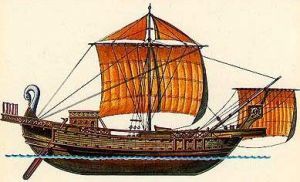
BIG, BIGGER, AND BIGGESTThe size of Roman ships often surprises people. On the low end were ships designed for the grain trade, which carried 10,000 modii of grain…a little over 75 tons. These were the workhorses of the fleet running regular routes to nearby Provinces to load wheat or barley. A government contract provided the ship owner with a steady source of income as his ship traced and retraced the same path back and forth between Rome and Sicily, Alexandria, or other export points.
Medium-sized ships were used extensively for the olive oil trade and were measured by the number of amphorae they could hold. A 3,000-amphora vessel had almost three times the capacity of the smaller ships, carrying 165,000 tons. The size of these ships is confirmed by numerous underwater explorations of ship wrecks. In addition to the specialized use previously mentioned, small and medium-sized ships hauled general merchandise as well. Metal ores and other raw materials, spices, silk and other trade goods moved with surprising regularity. For instance, in the First Century 120 ships a year set sail for India from the Red Sea port of Berenike. Their return cargo consisted of pepper which was moved by barge to Alexandria, and from there to Rome on still more ships.
The Roman fleet also had higher tonnage vessels. The hull of the Madrague de Giens, that floundered off Gaul (France) in the First Century BC, was 130 feet long with an estimated capacity of 440 tons. In the early years of the Roman Empire, the muriophorio,10,000-amphora carriers carrying 550 tons were the largest ships afloat. The grain trade also utilized some 50,000 modiivessels which hauled 365 tons. The size and capacity of these ships was not exceeded in the Mediterranean until the Sixteenth Century.
Yet the Roman world saw a few ships larger even than these. For instance, the carrier that Caligula built to transport an obelisk from Egypt to Rome had a capacity of 1450 tons. After it sank, it was used to construct the lighthouse at the port of Claudius. Various Emperors, Cleopatra among them, built barge-like floating palaces. Though designed for limited use in safe waters, some of them were nearly 250 feet in length.
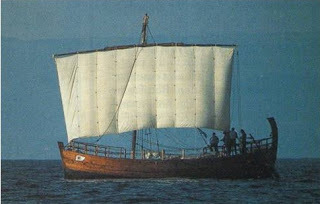 The Merchant Ship Afloat
The Merchant Ship AfloatSTANDARDIZED SHIPPING CONTAINERS
For olive oil and many other commodities, amphorae became the standard shipping container. So many amphorae arrived in Rome that disposing of the empties eventually created a problem. In 1999 an underwater search for a lost Israeli submarine turned up an ancient shipwreck at a depth of 10,000 feet. The ship came to rest on its keel then gradually tipped to one side. The weight of the amphorae in its hold caused the hull to lose structural integrity, spreading an oval mound of amphorae approximately 80 feet long and 50 feet wide on the seafloor. It is estimated that there are 2,500 amphorae in the pile. Based on its location halfway between Rhodes and Alexandria and the Greek wine it carried, archeologists surmise the ship was headed for Egypt.
When hearing the word amphora, many people think of an urn-like container. In fact, amphora is also a unit of measurement. An amphora equaled 3 modius. Since a modius contains 2 ½ gallons of liquid, each amphora on the seafloor represents 7½ gallons. So, if the 2,500 intact amphorae comprised the entire cargo, the ship was carrying 18,750 gallons, or 150,000 pounds, of wine when it sank.
Like most colonizing powers, over time Rome grew dependent upon the influx of goods from the Provinces to survive. Each year 60,000,000 modii of grain arrived in Rome. Assuming each vessel contained 50,000 modii, that works out to 1,200 shipments of grain annually. Navigation was not the year-round affair that it is today. Every winter saw the arrival of the mare clausum or closed sea that lasted four months. Subtracting this period of inactivity computes to an average of five large grain ships arriving every navigable day. It has also been calculated that seven or more large shiploads of olive oil docked each month. To those must be added the ships that transported wine, fish products, spices, cloth, ore, marble and stone blocks. There were also shiploads of wild animals arriving from Africa and elsewhere for use in the games.
All of this merchandise directed at Rome had to come through the Port of Ostia and later the Port of Claudius. Merchant ships which exceeded a 3000-amphora capacity, about 165 tons, could not travel upstream. They were obliged to anchor at sea and unload their cargo onto smaller vessels which shuttled between the ships and the river entrance to the Port of Ostia. These operations were lengthy and dangerous operations. The coastline in that area was inhospitable, low, and sandy.
Next time we’ll examine the ancient method of contemplative study of the scriptures known as Lectio Divina.
Until then, we wish you Peace and Blessings
If you reached this post via a link, click the HOME tab above to see other recent posts and visit our archives.
Published on May 09, 2012 01:00
May 7, 2012
FOODS OF THE FIRST CENTURY — FISH & FOWL
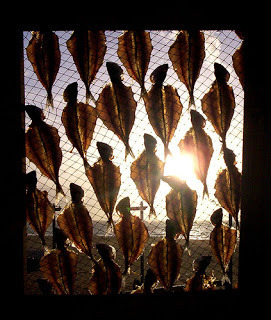 Hello My Friend and Welcome.
Hello My Friend and Welcome.Today we present another installment in our continuing series Foods of the First Century. If you’re new to Sowing the Seeds and would like to start at the beginning, or if you’ve missed one along the way, you can access the entire series by clicking on Foods of the First Century under the Archives by Topic header in the lower part of the left sidebar.
KASHRUT OR KOSHERSome clarifying notes are required before we begin our study of fish and fowl. Kashrut is the body of Jewish law dealing with what foods can and cannot be eaten and how those foods must be prepared. Kashrut comes from the Hebrew root Kaf-Shin-Reish, meaning fit, proper or correct. It is the same root as the more commonly used word kosher, which describes food that meets these standards. The word kosher can also be used, and often is, to describe ritual objects that are made in accordance with Jewish law and thus fit for ritual use.
The short answer to why Jews observe these laws is, because the Torah (The Law) says so. The Torah does not specify any reason for these laws, and for a Torah observant Jew, there is no need for any other reason. In his book To Be a Jew, Rabbi Hayim Halevy Donin suggests that the dietary laws are designed as a call to holiness. The ability to distinguish between right and wrong, good and evil, pure and defiled, the sacred and the profane, is very important in Judaism. The clean and unclean designations of Pharisaic Judaism, which prevailed at the time of Christ, were derived by attempting to codify these distinctions to the Nth degree.
As always, we’ll rely upon Biblical references to set us on our way. FISHAn important food source in ancient times and modern, fish are mentioned 37 times in the Old Testament (8 times in the Torah, 1 Kings, 2 Chronicles, Nehemiah, Job, Psalms, Ecclesiastes, Isaiah, Jeremiah, Ezekiel, Hosea, Amos, Jonah, Habakkuk, and Zephaniah) and 36 times in the New Testament…all but one being in the Gospels.
There were severe kosher restrictions relating to the consumption of seafood. Both Lev. 11:9 and Deut. 14:9 say, “Of the things that are in the waters, you may eat anything that has fins and scales…” Thus, shellfish such as lobsters, oysters, shrimp, clams and crabs were all forbidden. The Jew’s gentile neighbors, of course, regularly consumed shellfish.Fish of all varieties are permitted under Jewish law provided they have detachable scales. Some of the fish not considered kosher are: Angler See, Basa, Beluga (Sturgeon), Billfishes including Marlins and Swordfish, Blowfish, Catfish, Eels, Freshwater Cod, Lumpfish, Sharks, Rays and their relatives.
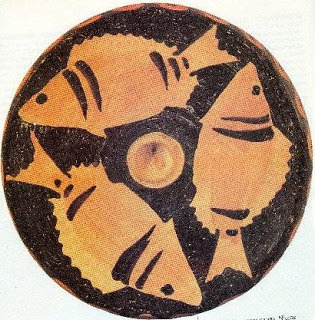 Fish Plate with Center Sauce DishAVAILABILITY OF FISHThe variety and availability of fish was primarily determined by geographic region. Judea, being on the Mediterranean Sea, enjoyed a wide variety of salt water fish. Fish were also plentiful in the region of Galilee because of Lake Genneserat…aka the Sea of Galilee or the Sea of Tiberias. The primary catch in the Sea of Galilee was the small bass we now know as Tilapia. Fresh fish were less plentiful in the eastern regions since their only source would have been small ponds, lakes, or the Jordan River.
Fish Plate with Center Sauce DishAVAILABILITY OF FISHThe variety and availability of fish was primarily determined by geographic region. Judea, being on the Mediterranean Sea, enjoyed a wide variety of salt water fish. Fish were also plentiful in the region of Galilee because of Lake Genneserat…aka the Sea of Galilee or the Sea of Tiberias. The primary catch in the Sea of Galilee was the small bass we now know as Tilapia. Fresh fish were less plentiful in the eastern regions since their only source would have been small ponds, lakes, or the Jordan River.FISH FARMINGFish farming is not a modern innovation. Both the Romans and the Jews operated fish farms. A particularly large group of fish ponds were constructed at Herod’s capitol, Caesarea. If not eaten fresh, the fish would have been split, cleaned, salted, and dried in the sun, or smoked, to preserve them for later use. Dried fish was a routine trade item throughout the Roman Empire. Galilean fishermen such as Simon Peter and his brother, Andrew, and their partners the Zebedees (James, John and their father) sold their catch all across the Eastern portion of the Roman Empire.
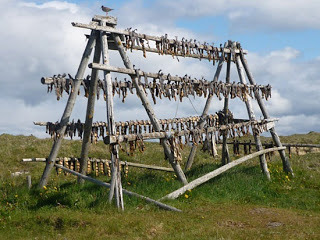
Tradition tells us that, in addition to a sales outlet in Capernaum, the Zebedee family also had a second market in Jerusalem. In the Passion narratives, recall that John was known to the gatekeeper at the High Priest’s house whereas Peter was not and had to rely on John to get him in. With reference to the Biblical story commonly called The Loaves and Fishes, the little boy with the two fish and seven barley loaves obviously had dried fillets, most probably Tilapia.
GARUM…THE POPULAR FISH SAUCEAnother staple of that era was Garum, or Liquamen, a salty, pungent fish sauce used both as a condiment and an ingredient in many recipes. Should you get a hankerin’ for some authentic Garum, here’s an ancient recipe from Gargilius Martialis’ cookbook, De medicina et de virtute herbarum: “Use fatty fish, for example, sardines, and a well-sealed container with a 26-35 quart capacity. Add dried, aromatic herbs possessing a strong flavor, such as dill, coriander, fennel, celery, mint, oregano, and others, making a layer on the bottom of the container; then put down a layer of fish (if small, leave them whole, if large, use pieces). Over this, add a layer of salt two fingers high. Repeat these layers until the container is filled. Let it rest for seven days in the sun. Then mix the sauce daily for 20 days. After that, it becomes a liquid.” Doesn’t that sound just yummy? If you’d rather not make your Garum by the gallon, here’s a modern alternative: Cook a quart of grape juice, reducing it to one-tenth its original volume. Dilute two tablespoons of anchovy paste in the concentrated juice and mix in a pinch of oregano. Be sure to let me know how it turns out.
 A GrouseFOWLPartridge (1 Samuel 26:20; Jeremiah 17:11) Pigeon (Genesis 15:9; Leviticus 12:8) Quail (Psalm 105:40) Dove (Leviticus 12:8)
A GrouseFOWLPartridge (1 Samuel 26:20; Jeremiah 17:11) Pigeon (Genesis 15:9; Leviticus 12:8) Quail (Psalm 105:40) Dove (Leviticus 12:8)
 A Quail in Israel
A Quail in IsraelThere are several interesting things to be gleaned from the above list. First, chicken is not mentioned. Chicken was known and available in the First Century, but generally reserved for the upper classes. Secondly, all of those birds listed were available wild. This isn’t to imply that everyone trapped their own birds, but I’m confident many in the rural areas did. We know from archaeological studies that aviculture was widespread and well developed in the ancient world. (See our earlier post Aviculture in Ancient Israel.) Interestingly enough, all of the birds in the list are still raised commercially.
 A Sand Partridge - Native to Israel
A Sand Partridge - Native to IsraelKOSHER RESTRICTIONS ON FOWLThe Torah also designates a number of birds as forbidden…all birds of prey or scavengers. Eggs from these non-kosher sources were forbidden as well. The Biblical list omits several groups of birds that comprised part of the First Century diet. For instance, waterfowl such as ducks and geese are not mentioned, but frequently appear in the writings of Roman historians. Grouse, or ptarmigan, are also overlooked, but were surely eaten. So there we have it, the Fish and Fowl of the Roman world available to the earliest Christians. Two weeks from now, on May 21st , we’ll examine Meats and Milk. Meanwhile, this coming Wednesday we’ll look at Roman Merchant Ships. Until then, we wish you Peace and Blessings. If you reached this post via a link, click the HOME tab above to see other recent posts and visit our archives.
Published on May 07, 2012 01:00
May 4, 2012
ANCIENT GAMES — DICE
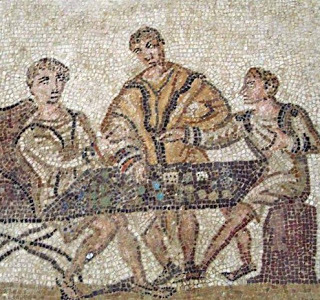 A Mosaic of Gamblers Playing Dice
A Mosaic of Gamblers Playing DiceHello My Friend and Welcome.
“God does not play dice with the universe,”- Albert Einstein. “God not only plays dice, He also sometimes throws the dice where they cannot be seen,”- Stephen Hawking. Do we sense a difference of opinion here?
Today we’ll be taking a look at Roman dice and dice games, or Tesserae. We have already done previous posts on the Roman game of Hounds and Jackals, the chess-like game, Latrunculi and most recently the line game known as Calculi that you may enjoy.
We must always keep in mind that the early Christians lived in a world dominated by Roman culture. Paraphrasing the old maxim, one could say, “When in the Roman Empire do as the Romans do.” And, in matters other than faith, that’s most likely what they did.
In Biblical terms, the rolling of the dice is known as casting lots. It’s a rather popular term, appearing in Leviticus, Numbers, Joshua, 1 Samuel, 1 Kings, 1 Chronicles, Nehemiah, Esther, Job, Psalms, Proverbs, Ezekiel, Joel, Obadiah, Jonah, Nahum, 2 Esdras, all four of the Passion narratives, and, finally, in Acts where the Apostles must choose a replacement for Judas. The Biblical view of dice is probably best expressed in Proverbs 16:33, “The lot is cast into the lap, but the decision is wholly from the Lord.”
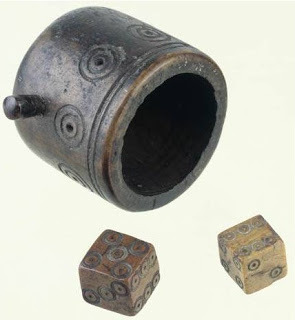 A Shaker Cup and a Pair of Dice
A Shaker Cup and a Pair of DiceIn addition to using dice to settle disputes or distribute goods impartially, they were also used for entertainment and gambling. One popular game was Tali. Like the familiar dice game Yahtzee, the count of the dice was scored like poker hands. No special board was needed. If you didn’t have dice, you used animal bones. A round consists of each player throwing and the winner of that round was the one with the best hand. Multiple hands could be added for a total score to determine the winner. A Venus was the highest hand and consisted of a one, three, four, and six. A Senio was a six with any combination of other numbers. Vultures were all the same numbers and the worst score you could get Dogs, was all ones.
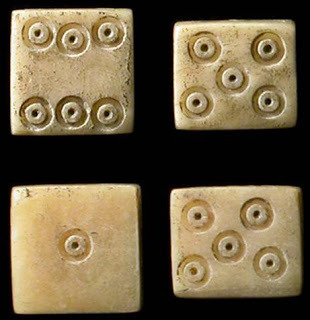
Like the dice we use today, opposite sides of the ancient Roman dice always added up to seven. (In case it’s been a while since you played Monopoly, the opposite sides of our dice are one and six, three and four, and two and five.) Dice were shaken in a cup then tossed, as croupiers do today. Bets were placed in much the same manner as they are today.
Dice games were played in taverns as well as gambling houses, brothels and on the street. The emperor Commodus, who was especially fond of gambling with dice, turned the Imperial Palace into a brothel and gambling house to raise money for the treasury when he bankrupted the Empire.
Gambling with dice was forbidden in the streets of Rome and Roman soldiers often fined the gamblers or made them move inside. Under Roman law, games of chance played for money were forbidden with the penalty being a fine of four times the value of the stakes. This led to the invention of another Los Vegas staple, gambling chips. Now the gamblers weren’t playing for money; they were playing for chips. That the chips were marked with specific symbols indicating their value didn’t seem to bother the authorities.
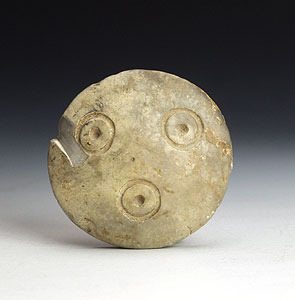
These chips, called roundels, have been found throughout the Roman Empire. They were made by turning and grinding sections of bone on a lathe, and then slicing it into discs. They carried numerical markings on one side, most commonly X, V and I. Many of the chips marked with an X have an extra vertical line through the middle, symbolizing a denarius. Chips have also been found labeled remittam libenter —I will gladly repay— the Roman equivalent of an I.O.U. Presumably, the repayment would have been made to or from the tavern or gambling club, much the same as is done with gambling tokens in Las Vegas today.
In a final aside, the Romans flipped coins just as we do. Coin tossing was known as capita aut navia, which means heads or ships. Early Roman coins always had a portrait of the Emperor on the face and ship on the tail side. Recall the words of Jesus when asked about the legality of paying taxes in Matthew 22:19-21. “Show me the coin used for paying the tax.” They brought him a denarius, and he asked them, “Whose image is this? And whose inscription?” “Caesar’s,” they replied. Then he said to them, “Render unto Caesar what is Caesar’s, and to God what is God’s.”
Next time we’ll return to Foods of the First Century for a study entitled Fish and Fowl. Until then, we wish you Peace and Blessings
If you reached this post via a link, click the HOME tab above to see other recent posts and visit our archives.
Published on May 04, 2012 01:00
May 2, 2012
FALSE MESSIAHS, DANIEL’S PROPHECY, & SABBATICAL YEARS
 A Potential Mashiach Gathering Followers
A Potential Mashiach Gathering FollowersHello My Friend and Welcome.
Today we look at the very interesting phenomena of the Sheker, or False Messiah. Jewish yearning for the Mashiachseems reached a fever pitch in the years prior to and in the years after the birth of Christ. Why? Well, part of the reason could have been the oppressive conditions under Roman rule, but the expected fulfillment of Daniel’s prophecy was probably also a factor.
THE BIBLICAL CONTEXTThe Law of Moses commanded that every 7th year be a Sabbatical Year. As the name suggests, the Sabbatical year is tied to the biblical concept of the Sabbath, the seventh day of the week and a time of rest. The Jubilee and Sabbatical years provided a form of regular debt release to stabilize social and economic gaps that naturally develop within every society.
According to the Hebrew Bible, during the seventh year all land had to be left untilled and unplanted, and debts from close neighbors that were unpaid during the previous six years were cancelled. These laws of land use and debt remission are not necessarily originally connected but appear to have been grouped together under a single general category of the Sabbatical year or Shemittah(Exodus 21:2-6, Exodus 23:10-11, Leviticus 25:1-7, 18-22, and Deuteronomy 15:1-11, 12-18) by the time the Bible was written.
In particular these laws addressed three specific concerns. First, they controlled overuse of the land. The laws also covered debt concerns. Because of drought and other cyclical crop failures, the poor needed to have a way to start over rather than languish in poverty. A similar consideration led to the introduction of Bankruptcy Laws in modern society. And, lastly, they addressed land ownership and management concerns that affected families in inter-generational settings. Other ancient near-eastern texts from the laws of Hammurabi and Ras Shamra (Ugarit) suggest similar concerns, but none of them have formulations as advanced or as specific as the laws of the Hebrew Bible.
THE HISTORIC REALITYJeremiah foretold that God would withhold His blessings and protection, because the nation of Judah had fallen away. He said Judah would be conquered and taken into a captivity which would last for 70 years (Jeremiah 25:12; 29:10). This was later fulfilled when Babylon conquered Judah and took them into captivity.
There is a belief that the observance of a Sabbatical year had apparently been neglected for most of Israel's history, so the Lord decreed they would spend one year in captivity for every sabbatical year they had failed to keep. They had missed 70 sabbatical years during their 490 years as a nation. The first deportation took place in 605 BC and the return occurred in 535 BC — 70 years.
Some validation for this belief can be found in the system of Rabbi Hillel, who lived in the First Century. He created a legal fiction (a prosbul or transference) that allowed for the repayment of a debt through a transfer of that debt from a personal loan to an institutional loan, thereby technically meeting the Sabbatical requirements, but allowing for repayment after the Sabbatical year. This prosbul is an example of the ways in which some Jews in the time of Christ ostensively met the spirit of the law, yet circumvented them in practice. Hence, his criticism of the Pharisees.
However, Daniel’s prophecy not only looked back in time, it also looked forward. It promised a Messiah who would come to make atonement for iniquity.The general consensus is that the some groups of Jewish teachers believed that the arrival of the Messiah was imminent. (Recall the meeting with Herod the Great after the Wise Men appeared searching for the Christ Child.) We also must keep in mind that the Sadducees accepted only the Torah, so the Temple aristocracy would have rejected any Messianic claims.
A LONG LIST OF FAILED ATTEMPTSThe list of Messianic Pretenders, or Shekers, can be short or long depending upon the criteria used. (One list continues into the Twentieth Century. Its most recent entry being an Hassidic Rabbi who died in the 1990’s.) For our purposes, the real interest lies with those who arose just prior to, or shortly after, the birth of Yeshua of Nazareth. This yields a list of thirteen individuals beginning with Athrongeus and ending with Simon bar Kokhbar in 132 AD.
My novel, WITNESSchronicles the rise and fall of the two earliest pretenders, Judas the Galilean and Athrongeus of Judea. Of the two, Judas had the greater impact. The Roman army executed most of Judas’ followers after his uprising. He, however, lived to fight another day. Retreating into the Galilean hills with a handful of supporters, he waged a guerilla war against the Romans for many years. The party of the Zealots arose from his movement.
Jacob & Simon, both sons of Judas the Galilean, are listed among the Messianic Pretenders. They were crucified by the Roman Governer Tiberius Julius Alexander in 47 AD. Seventy years after Judas’ revolt in Sepphoris the Zealot party seized control of Jerusalem, which led to the the famous Jewish Revolt and the city’s destruction by the Romans in 70AD.
Another Messianic Pretender is mentioned by Gamali’el in his speech to the Great Sanhedrin recorded in the Acts of the Apostles. (Acts 5:34-39) “But a Pharisee in the council named Gama'li-el, a teacher of the law, held in honor by all the people, stood up and ordered the men to be put outside for a while. And he said to them, "Men of Israel, take care what you do with these men. For before these days Theu'das arose, giving himself out to be somebody, and a number of men, about four hundred, joined him; but he was slain and all who followed him were dispersed and came to nothing. After him Judas the Galilean arose in the days of the census and drew away some of the people after him; he also perished, and all who followed him were scattered. So in the present case I tell you, keep away from these men and let them alone; for if this plan or this undertaking is of men, it will fail; but if it is of God, you will not be able to overthrow them. You might even be found opposing God!”
The Bar Kokhbar Revolt marked the last attempt by the Jews to establish a nation in ancient Israel. Though the Temple had been destroyed in 70AD, Jews still inhabited the territory in and around Jerusalem. Simon bar Kokhba ―Simon Son of a Star― is referenced in the Babylonian Talmud, in Cassius Dio’s Roman History, and in Eusebius’ Ecclesiastical History. He led a major Jewish revolt that took the Romans three years to put down. Coins minted during his reign are stamped “Year one of the redemption of Israel.” His defeat led to the absolute leveling of Jerusalem and the expulsion of all Jews from the Holy Land. His critics referred to him as bar Kozeba – Son of Disappointment.
 The Unfortunate End of a Failed Revolt
The Unfortunate End of a Failed RevoltWHAT MOTIVATED THESE MEN?It’s tempting to write these people off as rabble-rousers and riff-raff. Surely, some of them were. We see that same phenomena in modern society. How often does a city’s celebration of a championship team devolve into a riot in which shops are vandalized and looted? Clearly a share in the potential spoils motivated some of the followers of these failed rebellions.
However, to paint them all with such a broad brush seems unfair. Place yourself in their shoes. You’re dissatisfied, angry about the Roman occupation and a devout follower of the Judaism. You believe the prophecies of a coming Mashiach with all your heart. Who is he? Where is he? It suddenly occurs to you that maybe…just maybe, God is calling you to this task. After all, many Biblical heroes were reluctant heroes at best. How can you find out whether or not you’re the long awaited Mashiach? The only way is to test the vocation. If you succeed, the call is true.
Unfortunately, such a process forces you to place your life on the line.
A CLOSING THOUGHTInterestingly enough one, if not two, of Judas the Galilean’s followers apparently found a home among Yeshua’s disciples. Luke refers to the first as Simon Zelotes (Simon the Zealot). In Matthew and Mark the KJV identifies him as a Canaanite. This is an incorrect translation of the Hebrew word Cananean, which in Greek becomes Zealot.
It has been suggested that the name Judas Iscariot derives from the Greek word sikarios ― dagger bearer. The Sicarii were a band of fanatical nationalists who broke with the Zealots and assassinated perceived enemies with their daggers.
On Friday we’ll be examining the First Century game known as Tabula.
Until then, we wish you Peace and Blessings.
If you reached this post via a link, click the HOME tab above to see other recent posts and visit our archives.
Published on May 02, 2012 01:00
April 30, 2012
FOODS OF THE FIRST CENTURY - GRAINS
 Loaves of Flatbread Fresh from the OvenHello My Friend and Welcome. Today we have another installment in the ongoing series, Foods of the First Century along with a couple of interesting recipes. There are a few clarifying points that need to be made before we step into our study of grains. CORN IN THE BIBLEFirst, some translations of the Bible mention corn. Corn, or more properly, zea mays, is a new world grain and definitely not known to First Century inhabitants of the Levant. In the Middle Ages, the word corn was a catch-all word for grain. It could mean oats, rye, barley, wheat, etc. Consequently, when the Pilgrims came to the United States and encountered the crop zea mays — the Indians’ staple grain — they referred to it as corn. Which is why what Americans call corn is known everywhere else as maize. VARIETY NOT NECESSARYSecondly, there isn’t nearly the variety among the grains as we found in other categories we’ve visited. This shouldn’t be surprising. Think for a moment about our present world. Though we have an unprecedented number of grains available to us, the demand for wheat products and wheat flour far and away exceeds the demand for all of the other grains combined. When it comes to grains, variety is nice, but certainly not necessary. THE CEREAL GRAINSThe third, and last, point is that all cereal grain crops are grasses. Other than rice, corn, and grain sorghum, their growth habits are remarkably similar. By and large, the seeds themselves resemble each other. So much so that faced with a table full of bowls of grain, labeling them correctly could be a daunting task. (Trust me on this. As a final exam in an agronomy course, we once had to identify dishes of the common cereal grains as well as another set of dishes filled with common forage grass seeds. It’s not something you want to do.) The very earliest grains known to archaeologists are einkorn and emmer. Einkorn was a tough grain grown in Europe since the Mesolithic era. There is evidence of einkorn farming in the Karacadag Mountains in southeast Turkey 11,000 years ago and also around Jericho about the same time. Its use decreased with the growing popularity of newer varieties of wheat and today it is grown only as a specialty crop. Einkorn gluten does not cause the allergic reactions of modern wheat gluten and is often beneficial for those suffering from celeriac disease. As usual, we’ll base our list upon Biblical references.
Loaves of Flatbread Fresh from the OvenHello My Friend and Welcome. Today we have another installment in the ongoing series, Foods of the First Century along with a couple of interesting recipes. There are a few clarifying points that need to be made before we step into our study of grains. CORN IN THE BIBLEFirst, some translations of the Bible mention corn. Corn, or more properly, zea mays, is a new world grain and definitely not known to First Century inhabitants of the Levant. In the Middle Ages, the word corn was a catch-all word for grain. It could mean oats, rye, barley, wheat, etc. Consequently, when the Pilgrims came to the United States and encountered the crop zea mays — the Indians’ staple grain — they referred to it as corn. Which is why what Americans call corn is known everywhere else as maize. VARIETY NOT NECESSARYSecondly, there isn’t nearly the variety among the grains as we found in other categories we’ve visited. This shouldn’t be surprising. Think for a moment about our present world. Though we have an unprecedented number of grains available to us, the demand for wheat products and wheat flour far and away exceeds the demand for all of the other grains combined. When it comes to grains, variety is nice, but certainly not necessary. THE CEREAL GRAINSThe third, and last, point is that all cereal grain crops are grasses. Other than rice, corn, and grain sorghum, their growth habits are remarkably similar. By and large, the seeds themselves resemble each other. So much so that faced with a table full of bowls of grain, labeling them correctly could be a daunting task. (Trust me on this. As a final exam in an agronomy course, we once had to identify dishes of the common cereal grains as well as another set of dishes filled with common forage grass seeds. It’s not something you want to do.) The very earliest grains known to archaeologists are einkorn and emmer. Einkorn was a tough grain grown in Europe since the Mesolithic era. There is evidence of einkorn farming in the Karacadag Mountains in southeast Turkey 11,000 years ago and also around Jericho about the same time. Its use decreased with the growing popularity of newer varieties of wheat and today it is grown only as a specialty crop. Einkorn gluten does not cause the allergic reactions of modern wheat gluten and is often beneficial for those suffering from celeriac disease. As usual, we’ll base our list upon Biblical references.
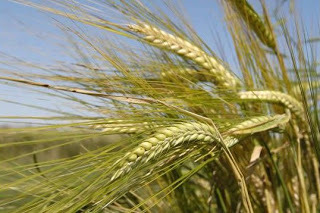 Barley Ripening in the FieldBarley (Deuteronomy 8:8; Ezekiel 4:9) Hordeum valgar, more commonly known as barley is one of the most ancient of all types of crops. It was domesticated in Mesopotamia, from its wild relative Hordeum spontaneum. Barley flour, and therefore barley bread, was the poor man’s staple in the First Century. Recall John 6:9 “There is a boy with five small barley loaves…” We must also remember that all bread would, by necessity, have been made from a starter. They ate what we commonly term sourdough breads. Packaged active dry yeast was not available commercially until the 1880’s. Most whole barley sold today is de-hulled, that is, its indigestible outer seed coat has been removed. Many stores also carry pearled barley which is polished after the hull was removed. Its white kernels make it an attractive alternative to rice. Barley can be eaten as pilaf, or in soups and stews.
Barley Ripening in the FieldBarley (Deuteronomy 8:8; Ezekiel 4:9) Hordeum valgar, more commonly known as barley is one of the most ancient of all types of crops. It was domesticated in Mesopotamia, from its wild relative Hordeum spontaneum. Barley flour, and therefore barley bread, was the poor man’s staple in the First Century. Recall John 6:9 “There is a boy with five small barley loaves…” We must also remember that all bread would, by necessity, have been made from a starter. They ate what we commonly term sourdough breads. Packaged active dry yeast was not available commercially until the 1880’s. Most whole barley sold today is de-hulled, that is, its indigestible outer seed coat has been removed. Many stores also carry pearled barley which is polished after the hull was removed. Its white kernels make it an attractive alternative to rice. Barley can be eaten as pilaf, or in soups and stews.
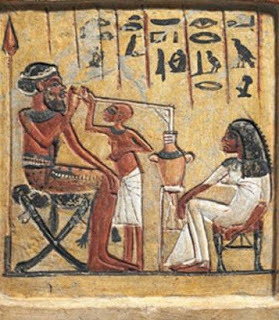 Egyptian Wall Painting of Man Drinking Beer
Egyptian Wall Painting of Man Drinking Beer The Egyptians discovered that bread baked with malted (sprouted) barley remained fresh longer than the plain variety. Because the malting process converted many of the grains starches into sugars, it also was highly fermentable. A clay tablet dating to 1,800 BC known as the Hymn to Ninkasi (the Sumerian Goddess of Brewing) contains an ancient recipe for making beer. Loaves of bread made of malted barley flour were twice-baked then crumbled into a mixture of malted barley and water, and left to ferment. Sweet syrup was added to the final mash. Ancient beers contained no hops; the brewers added sycamores instead. Recall from our post on fruits and nuts that this would reference sycamore figs, which probably supplied the sweetness mentioned above.
With no disrespect intended, have you ever imagined Jesus and his disciples gathering for a glass of beer after a hard day’s work? Records indicate that they most likely did.
 A Field of Flax in BloomFlax (Exodus 9:31) There are five references to flax in the Bible, but only one of these refers to the crop itself. The others are indirect references to linen. The flax plant is, of course, a dual crop. Its seeds are edible and the stems were beaten to free the fibers that were woven into linen. Linen was a premium fabric in the First Century. Flaxseeds can be added to breads, muffins and cookies for their nutritional value. The following recipe for flaxseed crackers fit the needs of the Early Christians. They were quick, easy and tasty…plus they don’t even require a lot of modern equipment; they could be dried in the sun.
A Field of Flax in BloomFlax (Exodus 9:31) There are five references to flax in the Bible, but only one of these refers to the crop itself. The others are indirect references to linen. The flax plant is, of course, a dual crop. Its seeds are edible and the stems were beaten to free the fibers that were woven into linen. Linen was a premium fabric in the First Century. Flaxseeds can be added to breads, muffins and cookies for their nutritional value. The following recipe for flaxseed crackers fit the needs of the Early Christians. They were quick, easy and tasty…plus they don’t even require a lot of modern equipment; they could be dried in the sun.
 Easy-to-Make Flaxseed CrackersIngredients: 1 cup flax seeds, 1 cup water, 1/8 cup soy sauce, 1/4 teaspoon garlic powder, 1/4 teaspoon curry powder, salt and pepper to taste. Process: Place the flax seeds and water in a medium bowl and mix. Let sit for 1-1/2 hours. The mixture will thicken. Preheat your oven to 300 degrees F. Line a rimmed baking sheet with parchment. Mix in the soy sauce, garlic and curry powders, and salt, pepper. Pour mixture onto baking sheet, spread into a large rectangle about 1/8-inch thick. Bake for 40 minutes, then check for firmness. If it's firm, flip and continue baking for another 40 minutes or so. If not, keep baking a little longer. You'll want 'em crispy versus chewy for taste. Cool and cut or break your large cracker into bite-sized squares. [You can also make them in a dehydrator…use a tray designed for fruit leather.] Millet (Ezekiel 4:9) Birdseed is the first thing most people think of when millet is mentioned, and rightly so. Millet is the primary food of most caged birds. However, millet is particularly suited to semi-arid conditions and it is grown and eaten by a substantial part of the population in Africa, the Middle East, and parts of Asia. Millet flour is used to make flatbreads, muffins and cookies. Whole millet can be cooked into porridge and eaten for breakfast, or made into pilaf with herbs and vegetables. The people of Senegal make a stew of cooked millet, chickpeas, cabbage, onions, garlic, root vegetables and peanut butter. (Peanuts, by the way, are known as ground nuts in Africa.)
Easy-to-Make Flaxseed CrackersIngredients: 1 cup flax seeds, 1 cup water, 1/8 cup soy sauce, 1/4 teaspoon garlic powder, 1/4 teaspoon curry powder, salt and pepper to taste. Process: Place the flax seeds and water in a medium bowl and mix. Let sit for 1-1/2 hours. The mixture will thicken. Preheat your oven to 300 degrees F. Line a rimmed baking sheet with parchment. Mix in the soy sauce, garlic and curry powders, and salt, pepper. Pour mixture onto baking sheet, spread into a large rectangle about 1/8-inch thick. Bake for 40 minutes, then check for firmness. If it's firm, flip and continue baking for another 40 minutes or so. If not, keep baking a little longer. You'll want 'em crispy versus chewy for taste. Cool and cut or break your large cracker into bite-sized squares. [You can also make them in a dehydrator…use a tray designed for fruit leather.] Millet (Ezekiel 4:9) Birdseed is the first thing most people think of when millet is mentioned, and rightly so. Millet is the primary food of most caged birds. However, millet is particularly suited to semi-arid conditions and it is grown and eaten by a substantial part of the population in Africa, the Middle East, and parts of Asia. Millet flour is used to make flatbreads, muffins and cookies. Whole millet can be cooked into porridge and eaten for breakfast, or made into pilaf with herbs and vegetables. The people of Senegal make a stew of cooked millet, chickpeas, cabbage, onions, garlic, root vegetables and peanut butter. (Peanuts, by the way, are known as ground nuts in Africa.)
 Oats Though not specifically mentioned in the Bible, oats were domesticated in Europe about 1000 BC. They originated as weeds that grew within cultivated fields of various other crops. Even today, they can grow in ditch banks and other places there not wanted; hence the expression, “Sowing one’s wild oats."
Oats Though not specifically mentioned in the Bible, oats were domesticated in Europe about 1000 BC. They originated as weeds that grew within cultivated fields of various other crops. Even today, they can grow in ditch banks and other places there not wanted; hence the expression, “Sowing one’s wild oats." Oats were slow to gain popularity because they did keep as well as other cereal grains. They have a tendency to go rancid very quickly, due to the presence of natural fats and a fat dissolving enzyme present in the grain. Greeks and Romans considered oats to be nothing more than a diseased version of wheat. Oats were a lowly horse food for the Romans. They scoffed at the Germanic tribes of Northern Europe, calling them oat-eating barbarians. So we can say with certainty that people of the First Century knew and had oats. What they did with them is another story. Even today, less than 5% of the oats grown commercially are for human consumption.
 Spelt Ripening in the Field
Spelt Ripening in the FieldSpelt (Ezekiel 4:9) Modern wheat traces its roots to three ancient grains: einkorn, emmer, and spelt. Spelt, which has a distinctly nutty flavor, has been cultivated in the Fertile Crescent for 9,000 years. Most of the spelt produced in the United States is grown in Ohio, which devotes between 100,000 and 200,000 acres to spelt production annually. Ground spelt is primarily used in animal feeds as an alternative to oats and barley. Its nutritional value is close to that of oats. After it is hulled, Spelt can also be used as a food grain for people. It is popular in Europe, particularly in Germany. Spelt can also be used in flour and baked goods to replace soft red winter wheat.
Wheat (Ezra 6:9; Deuteronomy 8:8)
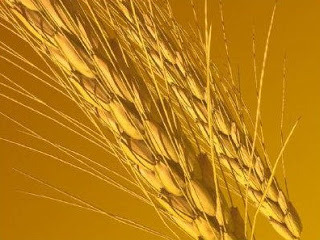 Emmer, an original staple of farming in the Levant, has small grains and is related to modern durum wheat. Emmer was eaten by the ancient Egyptians and is still farmed there today. When wheat is mentioned, the first thing people think of is flour. Wheat flour is lighter and softer than barley flour and was used for bread by the upper classes. The Durum wheat mentioned above produces white flour known as semolina. Today, semolina is used primarily for the production of pasta.
Emmer, an original staple of farming in the Levant, has small grains and is related to modern durum wheat. Emmer was eaten by the ancient Egyptians and is still farmed there today. When wheat is mentioned, the first thing people think of is flour. Wheat flour is lighter and softer than barley flour and was used for bread by the upper classes. The Durum wheat mentioned above produces white flour known as semolina. Today, semolina is used primarily for the production of pasta. Wheat also yielded two of the ancient world’s fast foods: Bulghur and Freekeh.
 A Dish of TaboulehBulghur is wheat that has been hulled, parboiled, dried and chopped. The parboiling precooks the grain allowing it to quickly reconstitute when soaked in water. Bulghur is served warm, or unheated as a salad. The most familiar form would be Tabbouleh, which consists of reconstituted bulghur, tomatoes, cucumbers, chopped parsley, sliced green onions, chopped mint, olive oil, lemon juice, salt, allspice, cinnamon and pepper. From earlier posts we can see that only the tomatoes present a problem for the First Century cook. They had it all, except the tomatoes.
A Dish of TaboulehBulghur is wheat that has been hulled, parboiled, dried and chopped. The parboiling precooks the grain allowing it to quickly reconstitute when soaked in water. Bulghur is served warm, or unheated as a salad. The most familiar form would be Tabbouleh, which consists of reconstituted bulghur, tomatoes, cucumbers, chopped parsley, sliced green onions, chopped mint, olive oil, lemon juice, salt, allspice, cinnamon and pepper. From earlier posts we can see that only the tomatoes present a problem for the First Century cook. They had it all, except the tomatoes.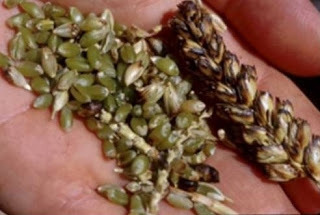 Frekeeh After Burning and HuskedThough similar, Freekeh has its own unique character. Durum wheat is harvested green while the kernels are soft and full of moisture. Then it’s allowed to dry in the sun before being placed on an open fire. The straw and chaff burn away, turning the wheat a dark golden color. The grains are then polished and cracked. Freekeh is said to have a unique smoky aroma and a nutty, toasted taste. It is used to make savory pilafs and other Middle Eastern side dishes.
Frekeeh After Burning and HuskedThough similar, Freekeh has its own unique character. Durum wheat is harvested green while the kernels are soft and full of moisture. Then it’s allowed to dry in the sun before being placed on an open fire. The straw and chaff burn away, turning the wheat a dark golden color. The grains are then polished and cracked. Freekeh is said to have a unique smoky aroma and a nutty, toasted taste. It is used to make savory pilafs and other Middle Eastern side dishes. And now the second recipe— I looked for a Biblical reference to Bulghur and I believe it can be found in Samuel 17:17 in which Jesse tells David to take food to his brothers in Saul’s army. The NIV translation says, “Take this ephah of roasted grain.”The KJV says, “Take now for your brothers an ephah of this dried grain.” Then I checked the Douay Rheims, which follows the Latin Vulgate. It said, “Take for thy brethren an ephah of frumenty.” Frumenty is a thick porridge made from Bulghur. The oldest available recipe comes from the early Middle Ages. Curye on Inglysch To make frumente. Tak clene whete & braye yt wel in a morter tyl the holes gon of; sethe it til it breste in water. Nym it up & lat it cole. Tak good broth & sweet mylk of kyn or of almand & tempere it therwith. Nym yelkys of eyren rawe & saffroun & cast therto; salt it; lat it naught boyle after the eyren ben cast therinne. Messe if forth with venesoun or with fat motoun fresch. Hmmm. Here’s a translation along with comments. Keep in mind I haven’t read Old English since my senior year in high school English when we read Chaucer in its original form. A Recipe in EnglishTo make frumenty. Take clean wheat and pound it well in a mortar until the hulls are off. Boil the hulled wheat in water until it cracks. Take it out and let it cool. [We have now made Bulgur wheat.] Combine a good broth and sweet almond milk, and bring them to a boil. Add the wheat and reduce heat. [Stirring so it doesn’t stick.] Take raw egg yolks and saffron and add them to the pot. Do not let it boil after the eggs are put in. [Remove from heat and let stand to thicken.] Serve with venison or fresh fat mutton. So there you have it, the grains the early Christians had available and a few ways in which they might have prepared them. The more we learn about these earlier times, the more we can appreciate the diverse cuisine they enjoyed. Once we’ve covered the basics, we can turn our concentration to the dishes they prepared. One of our resources for recipes is an ancient Roman cookbook. Stay tuned. On Wednesday we’ll study the phenomena of Shekers, or False Messiahs in ancient Israel. Until then, we wish you Peace and Blessings. If you reached this post via a link, click the HOME tab above to see other recent posts and visit our archives.
Published on April 30, 2012 01:00
April 26, 2012
KING SOLOMON’S MINES

Hello My Friend and Welcome.
The term King Solomon’s Mines conjures up all sorts of images. Perhaps it does for you as well. The book, yes it was a book long, long before it ever became a movie, has been memorialized in film three times.
It’s interesting to compare the three posters. It’s amazing how positively chaste Deborah Kerr looked in the 1950 version. Very in keeping with the Victorian time period in which the novel was set. Note also that she got star billing, not Stewart Granger who played the film’s lead character. In1985 Sharon Stone received equal billing with Richard Chamberlain, but her attire had become decidedly skimpier. Then there’s the 2004, made-for-TV version in which all the focus is on Patrick Swayze. Poor Alison Doody is so well hidden that no one but her immediate family even would have even known she was in it.
THE ORIGINAL ALLAN QUATERMAINPerennial favorites such as King Solomon’s Mines continue to fascinate. Not only do you have a serial character who continues for decades, but Hollywood can’t seem to get enough. The novel was written by Victorian adventure writer and fabulist Sir H. Rider Haggard. It tells the story of a search of an unexplored region of Africa by a group of adventurers led by Allan Quatermain. It is considered to have been the originator of the Lost World literary genre.
It was published in September 1885 amid great fanfare. Billboards and posters around London announced it as The Most Amazing Book Ever Written. By the late 19th century, explorers were uncovering ancient civilizations around the world and King Solomon's Mines captured the public's imagination. It became an immediate best seller. It also became a cash cow for Haggard and his publisher. Eighteen Quatermain books were eventually published under titles such Hunter Quatermain’s Story, The Monster, The Treasure of the Lake, The Ancient Allan, and Allan and the Ice-gods.
A WHOLE NEW GENRE OF FICTIONThis new genre would eventually inspire Edgar Rice Burroughs’ The Land That Time Forgot, Arthur Conan Doyle's The Lost World, Rudyard Kipling's The Man Who Would Be King and HP Lovecraft's At the Mountains of Madness, even Michael Crichton's Congo. It also created the recurring male character who leads an exotic life, breaks all the rules, but succeeds anyway…think James Bond, Indiana Jones, etc., etc., etc. GOING FROM FICTION TO REALITYEnough nostalgia; this post isn’t about old books or movie heroes, it’s about the real for sure mines of King Solomon the Wise, the man who built the First Temple in Jerusalem. For nearly 3,000 years the location of these mines, and whether they existed at all, has remained a mystery. No longer. Researchers using carbon dating techniques at a site in Khirbat en-Nahas (Arabic for Ruins of Copper) in southern Jordan have verified that copper production took place there around the time King Solomon ruled the Israelites.
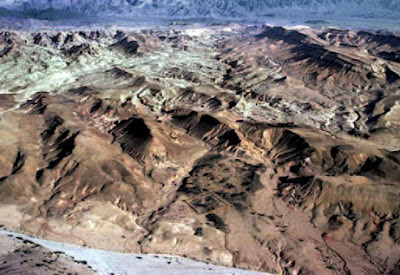 Aerial View of the Mine SiteCopper? What happened to all the gold and diamonds and ivory and other neat stuff, you ask? This is where we separate fact from fiction. Sorry to say, it was never there to begin with. Haggard also sent Quatermain to darkest Africa on his quest instead of the Middle East. He’s not the only novelist who played fast and loose with the facts, but why quibble with success? Especially success on a scale such as this. VALIDATING BIBLICAL HISTORYThomas Levy of the University of California San Diego, who led the research, said their work placed copper production at Khirbat en-Nahas in the 10th century BC in line with the biblical narrative of Solomon's rule. “…this research represents a confluence between the archaeological and scientific data and the Bible."
Aerial View of the Mine SiteCopper? What happened to all the gold and diamonds and ivory and other neat stuff, you ask? This is where we separate fact from fiction. Sorry to say, it was never there to begin with. Haggard also sent Quatermain to darkest Africa on his quest instead of the Middle East. He’s not the only novelist who played fast and loose with the facts, but why quibble with success? Especially success on a scale such as this. VALIDATING BIBLICAL HISTORYThomas Levy of the University of California San Diego, who led the research, said their work placed copper production at Khirbat en-Nahas in the 10th century BC in line with the biblical narrative of Solomon's rule. “…this research represents a confluence between the archaeological and scientific data and the Bible."
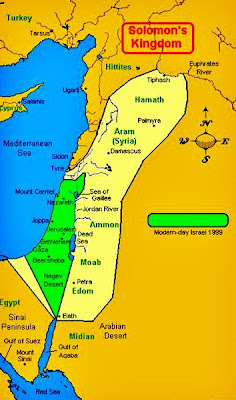
As you can see from the map, Solomon’s influence encompassed the entire region. Khirbat en-Nahas is an arid region south of the Dead Sea, which the Old Testament identifies as the Kingdom of Edom. As early as the 1930’s, archaeologists linked the site to the Edomite Kingdom, but their claims were dismissed in subsequent years because it was believed that the area was unsettled in Solomon’s time. “Now ... we have evidence that complex societies were indeed active in 10th and 9th centuries BC and that brings us back to the debate about the historicity of the Hebrew Bible narratives related to this period,” Levy said It's not every day that science and the Bible come together to tell a piece of history. Modern dating methods have determined that huge mines in Jordan are 3000 years old, supporting the idea that they were the Biblical mines of Edom ruled by King David and his son Solomon. USE OF CARBON DATINGThe results of carbon dating on samples of charcoal used to smelt the ore were extremely consistent and leave no doubt as to the period during which the mines were active. This new evidence suggests that the site, one of the oldest, largest, and best preserved mines in the world, really is the one mentioned in the Bible.
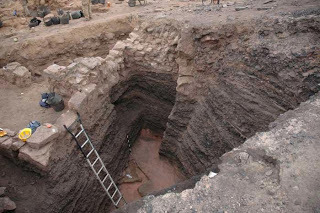 Looking Down into the DigThe team sampled charcoal from successive layers throughout a 20-foot-deep stack of smelting waste. The carbon at the base of the pit, the transition point between virgin earth, is 3000 years old. This indicates that smelting activity began there around 1000 BC. This initial phase is estimated to have lasted about 50 years. After that a large building was constructed on the site and copper production continued until about 800 BC. PROOF POSITIVEIn what would have been the floor level of the building, archaeologists found two ancient Egyptian stone and ceramic artifacts: a scarab and an amulet. Since neither one of them is made of local materials, they are believed to have been brought in during the military campaign of the Egyptian Pharaoh Sheshonq I, known as Shishak in the Old Testament. They are dated around the time of the building's construction when an abrupt change in the rate of copper production occurred. This is believed to be evidence for the role Sheshonq I may have played in the disruption of the largest known copper factory in the eastern Mediterranean. The unanswered question is who actually controlled the mines…David, Solomon, or the region’s Edomite leaders. Either way, it’s a fascinating discovery. Next time, we’ll return to our Foods of the First Century with a post on Ancient Grains. Until then, we wish you Peace and Blessings. If you reached this post via a link, click the HOME tab above to see other recent posts and visit our archives.
Looking Down into the DigThe team sampled charcoal from successive layers throughout a 20-foot-deep stack of smelting waste. The carbon at the base of the pit, the transition point between virgin earth, is 3000 years old. This indicates that smelting activity began there around 1000 BC. This initial phase is estimated to have lasted about 50 years. After that a large building was constructed on the site and copper production continued until about 800 BC. PROOF POSITIVEIn what would have been the floor level of the building, archaeologists found two ancient Egyptian stone and ceramic artifacts: a scarab and an amulet. Since neither one of them is made of local materials, they are believed to have been brought in during the military campaign of the Egyptian Pharaoh Sheshonq I, known as Shishak in the Old Testament. They are dated around the time of the building's construction when an abrupt change in the rate of copper production occurred. This is believed to be evidence for the role Sheshonq I may have played in the disruption of the largest known copper factory in the eastern Mediterranean. The unanswered question is who actually controlled the mines…David, Solomon, or the region’s Edomite leaders. Either way, it’s a fascinating discovery. Next time, we’ll return to our Foods of the First Century with a post on Ancient Grains. Until then, we wish you Peace and Blessings. If you reached this post via a link, click the HOME tab above to see other recent posts and visit our archives.
Published on April 26, 2012 01:00
April 24, 2012
BOADICEA’S LEGACY – THE TALE OF TWO CITIES & THE ARTHURIAN LEGEND
 The Romans Set Fire to the Temple of Claudius, Killing all Inside
The Romans Set Fire to the Temple of Claudius, Killing all InsideHello My Friend and Welcome.
A TALE OF TWO CITIES Today we’re looking at two ancient cities in Roman Britannia, Camulodunum (present day Colchester) and Londinium (present day London). They shared a common fate; during Queen Boadicea’s revolt against the Romans both of them were destroyed. [If you missed the first post on Boadicea, you can find it HERE.]
Both cities were rebuilt, of course, but the rebuilding process altered the relationship between them in interesting ways. Before we’re through we’ll also examine a possible origin for the Arthurian Legends and what some people have speculated may have given rise to them.Cities seem to have a life of their own. They rise, fall, and sometimes rise again. And then, sometimes they don’t. We recently examined the slide of Antioch into near oblivion, a city once known as The Queen of the East, and compared it to the other two great cities of the Roman Empire: Rome and Alexandria. You can find the Antioch post HERE.
Based on writings by Pliny the Elder, Cunobelinus (Colchester) is reputedly the oldest recorded town in Britain. Before the Roman conquest of Britain it was already a center of power for Cunobelin, king of the Celtic tribe, the Catuvellauni (5 BC - AD 40).
IMORTALIZED BY SHAKESPEAREInterestingly enough, Cunobelin appeared as Cymbeline in the Shakespearean play by the same name. In the play, Cymbeline, King of Britain, takes a new wife who has an arrogant son called Cloten. Cymbeline's lovely daughter Imogen is expected to marry Cloten. Instead Imogen marries the brave, but poor Posthumus Leonatus. Cymbeline is furious when he finds out about the marriage and banishes Posthumus. The couple have time to exchange love tokens and Imogen gives Posthumus a diamond ring and he gives her a bracelet. The villain of the plot is Iachimo who bets 10,000 ducats against Posthumus's diamond ring that he can seduce Imogen.
RETURNING TO CAMULODUNUMCunobelinus is better known by its Celtic name, Camulodunum, meaning fortress of Camulos, the Celtic War god. This is undoubtedly due to the fact that the Romans retained the name after their conquest of Britain in AD 43 and established a legionary fortress there. Later, when the Roman frontier expanded and Legio XX moved to the west, Camulodunum became the provincial capital of Roman Britannia. A large, and elaborate, Temple to the Divine Claudius was built in the city. It was there that thousands of Romans took refugee when Boadicea’s troops attacked the city. They all died when the rebels set fire to the Temple. And that is when Camulodunum’s, or Colchester’s, fate was sealed.
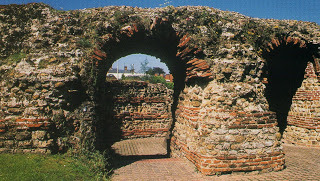 Remnants of the Wall the Romans Built Around Their FortressBoadicea’s fires had the strange effect of baking the wattle-and-daub buildings of Camulodunum into a solid mass. You might say the fire became an impromptu kiln. Because of this, the lower two feet of the Roman fortress survived and eventually became the underpinnings of the rebuilt colony. The town might have remained the financial capitol of Britain had the Romans not chosen to build their Colonia Victricensis, City of Victory, on the foundations of a fortress alongside the Colne River. The river’s marshy upper reaches made it nearly impossible for large merchant ships to reach the Roman settlers. In order to meet the demand for imported goods, shipping moved to the deeper waters of the Thames. And Londinium, which had previously been an insignificant trading center, grew to become the island’s center of commerce.
Remnants of the Wall the Romans Built Around Their FortressBoadicea’s fires had the strange effect of baking the wattle-and-daub buildings of Camulodunum into a solid mass. You might say the fire became an impromptu kiln. Because of this, the lower two feet of the Roman fortress survived and eventually became the underpinnings of the rebuilt colony. The town might have remained the financial capitol of Britain had the Romans not chosen to build their Colonia Victricensis, City of Victory, on the foundations of a fortress alongside the Colne River. The river’s marshy upper reaches made it nearly impossible for large merchant ships to reach the Roman settlers. In order to meet the demand for imported goods, shipping moved to the deeper waters of the Thames. And Londinium, which had previously been an insignificant trading center, grew to become the island’s center of commerce. 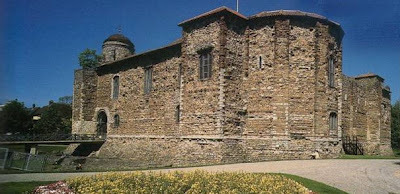 Colchester Castle Dates to the 11th CenturyABOUT THOSE ARTHURIAN LEGENDSDr. John Morris (1913-1977) an English historian who specialized in the study of the institutions of the Roman Empire and the history of Roman Britain, suggested in his book The Age of Arthur that as the descendants of Romanized Britons looked back to a golden age of peace and prosperity under Rome the name Camelot of the Arthurian legends was probably a reference to Camulodunum, the city of the Iceni god Camulos and capital of Britannia in Roman times.
Colchester Castle Dates to the 11th CenturyABOUT THOSE ARTHURIAN LEGENDSDr. John Morris (1913-1977) an English historian who specialized in the study of the institutions of the Roman Empire and the history of Roman Britain, suggested in his book The Age of Arthur that as the descendants of Romanized Britons looked back to a golden age of peace and prosperity under Rome the name Camelot of the Arthurian legends was probably a reference to Camulodunum, the city of the Iceni god Camulos and capital of Britannia in Roman times.  Boadicea Window in Colchester City Hall Studies say that Colchester (Camulodunum) was abandoned as a settlement after the sixth century. Sometime over the next three hundred years it underwent a revival. When and how is unclear. However, the ninth-century Historia Brittonum, mentions the town, which it calls Cair Colun, in a list of the thirty most important cities in Britain. The tenth-century Saxons called the town Colneceastre, which eventually became Colchester.
Boadicea Window in Colchester City Hall Studies say that Colchester (Camulodunum) was abandoned as a settlement after the sixth century. Sometime over the next three hundred years it underwent a revival. When and how is unclear. However, the ninth-century Historia Brittonum, mentions the town, which it calls Cair Colun, in a list of the thirty most important cities in Britain. The tenth-century Saxons called the town Colneceastre, which eventually became Colchester. Two thousand years ago, Camulodunum was the center of everything and Londinium was a backwater trading outpost. The current population of Colchester is 160,000, which is dwarfed by London’s 7.6 million. How far the mighty have fallen.
On Thursday, we’ll visit the myth and facts surrounding King Solomon's Mines. Look out Allan Quatermain, here we come!
Until then, we wish you Peace and Blessings.
If you reached this post via a link, click the HOME tab above to see other recent posts and visit our archives.
Published on April 24, 2012 01:00
April 20, 2012
CHRISTIAN WRITER’S BLOG CHAIN — JOY

Hello My Friend and Welcome.
As you can see, the Blog Chain’s topic word this month is JOY and, as usual, I’ll view it through the lens of the writing life. I’ll do this by sharing the results of my recent eBook promotion via Amazon’s KDP Select Free Days. Please understand, this is not an attempt on my part to brag. Many have done better. Rather, by sharing facts and figures, I hope to offer other writers details and insights that may benefit their marketing efforts.
But first, let’s talk about joy. Our world tends to use joy and pleasure as synonymous terms. This is a mistake. Pleasure is a fleeting, and often superficial, emotion. We can derive pleasure from a Big Mac and fries, but never joy. Joy resides deep in our soul and comes from a sense of inner peace, satisfaction and contentment. And so, I look back on this campaign with joy rather than pleasure, and the reason for this has very little to do with the results we achieved.
A JOINT EFFORTTechnology, especially in the computer age, is like everything else, both good and bad. We all know about the bad stuff — Spam, Hackers, Porn, Predators, etc. We don’t often think about the good it brings. This digital world of ours connects us in unimaginable ways. Notice in the previous paragraph I said the results we achieved. This was never a solitary effort. Had it been, it would have surely failed. Friends, good friends, whom I have never met and will probably never meet face-to-face helped immeasurably by taking time to share my Face Book posts and spread the word via blogs, tweets, etc.
I can’t begin to tell you how gratifying this is. The Desiderata says, “With all its sham, drudgery and broken dreams, it is still a beautiful world.” So long as people continue to reach out to each other in support and friendship, that will remain true. I haven’t sent individual Thank You’s because I know how easy it would be to overlook someone, and I wouldn’t want to do that. I thank you all right now. Believe me, I am extremely grateful to each and every person who assisted me in this effort.
BENEFITS FOR AMAZON FROM KDP SELECTFirst, let’s lay some groundwork. In a nutshell, KDP Select moves an eBook into a special category making it available for borrowing by Amazon Select members. The Amazon Select program offers free shipping for an annual membership fee. As an added bonus, members can borrow stipulated Kindle books from a Digital Lending Library at no cost. In order to enroll a book in KDP Select, the author/publisher has to give Amazon exclusive digital distribution rights for a series of self-renewing 90-day periods. Thus Amazon is able to make membership in their Select program more attractive.
BENEFITS FOR THE AUTHOR/PUBLISHERIn order to create a catalog of borrowable books, Amazon agreed to pay a fee each time an eBook is borrowed. It’s volume driven and has ranged from a low of $1.60 to a high of $2.18 last month. They further sweetened the pot by giving each book up to five free promotional days within each 90-day period. The belief was, and results verify, that giving away free books generates word of mouth and stimulates sales and borrows.
DECIDING TO ENROLL BOOKS IN KDP SELECTAt first I shied away from the program, viewing it as a thinly disguised attempt by Amazon to reassert its monopoly on eBooks. Their first attempt was the Kindle, which worked well until companies such as Sony, Apple, B&N and others began marketing their own reading devices. I held back because I didn’t want to forego the sales I derived from those other platforms. What changed my mind was an in-depth analysis of my sales reports. I write in three genres, Contemporary Fiction, Christian Fiction and Christian Nonfiction. For reasons I don’t claim to understand, my Christian books sell equally well across all platforms. However, the Contemporary Fiction has not. Amazon Kindle far and away represented my best market for PROMISES and LOST. Armed with this nugget of insight, I agreed to move them both into the KDP Select category. After all, I had little to lose.
PREPARING FOR YOUR FREE DAYSOnce I decided to have a Free Day Promotion, the first thing I did was re-edit PROMISES. It’d been on the market going on three years and I wanted to tighten and tone the content a bit. Next, we re-formatted both digital manuscripts (PROMISES & LOST). If the books were moving into the Select category where they’d be heavily promoted, I wanted to provide a maximum reading experience. This meant they had to be as error-free as possible. Since Claudia Monet, the MC in PROMISES, appears in ten chapters of LOST, we inserted a book promo and sample chapter of the other book in both of them. My hope was that we’d not only stimulate interest in PROMISES, but encourage the reader to buy LOST…and vice-versa.
The I began to research how others utilized their Free Days. The first thing I found out was that a successful promotion yielded what marketers call a tail. In other words, the buzz generated by putting all these free copies into circulation creates ongoing word of mouth that (hopefully) translates into solid sales. One thing to keep in mind when planning your promotion is that the numbers others have posted may be skewed due to timing. An enormous number of people received a Kindle for Christmas. Along with them Amazon offered a 30-day free trial in Amazon Select. So, if you happened to be lucky enough to schedule your free days in the early part of the year, you no doubt got a boost in borrowing from the trial members and additional downloads from people wanting to test drive their new Kindle.
WITH A LITTLE HELP FROM MY FRIENDSAs the time for your free days rolls around, you want to try to gin up as much publicity as possible. I’ve already mentioned the person-to-person contacts of Face Book, Twitter, Linked-In, etc. There are also websites specifically dedicated to free Kindle Books. I’ve included a link list at the end of the post.
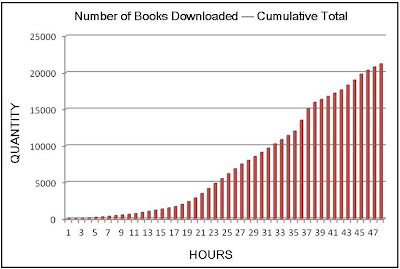
CRUNCHING THE NUMBERSI’ve created three graphs of my results. One details the cumulative total of eBooks downloaded over the two-day period by hour, which was 21,200. The second graph shows the approximate distribution of downloads hour-by-hour. (I had to do some averaging and smoothing because I wasn’t up all night to check and left home and the computer for several periods during the day.) The thing I immediately noticed is the gradual buildup of momentum. We have two outliers around the middle of the second day which I can’t explain. It may have something to do with the timing of tweets, Face Book posts and so on. Or, since these promotions are worldwide and noon on the West Coast corresponds to evening in Europe, it could be due to time differences. Whatever the reason, I’m glad to have them.
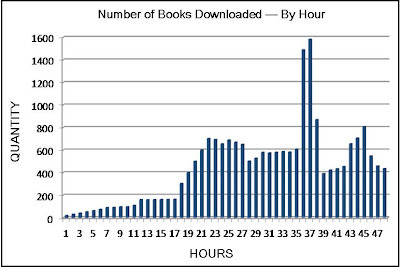
Rather than simply throwing numbers at you, let’s try to bring them into focus by comparing them to what other books were doing during the same period. This comparison is what convinced me that the promotion was indeed successful. On the second day, PROMISES reached its high, ranking 6th in the top 100 free books on Kindle. It held that position all day and well into evening. It also ranked 2nd in the Romantic Suspense category and 3rd in Contemporary Fiction.
I should also mention that when uploading the edited/re-formatted files, we adjusted the genre categories slightly. I strongly suggest you consider fine-tuning your choices in this department. It’s important to choose categories which accurately reflect the content of your book. This is, after all, the search criteria most people will use to find you. Clearly, you can’t help yourself by lying. Tagging a cozy mystery as a crime thriller or a sweet romance as erotica may generate additional uploads, but it won’t satisfy readers.
EXAMINING THE RESULTSOkay, so you’ve worked hard, done everything right, and promoted like crazy. This is the point at which you rest on your laurels and bask in the glow of your accomplishments. People all over the world now know your book exists. A heady thought that one. My third graph reveals the after effects of the promotion, the resulting sales.
My campaign ended 4/12/12 and this post goes up on 4/20/12, meaning I only have seven data points to graph. It does, however, give some hint of the payback from Kindle Free Days. I believe it also illustrates the benefit of cross-pollination. I tracked the number of books sold and those borrowed for both books. Basec on someone else's stats, they had follow-up sales of 2.37% of the freebies and borrows of 0.46%. Even thought she put out nearly 40% more books than I did, I adopted those percentages my goal. In the last seven days PROMISES had sales of 483 units , or 96% of the goal. 120 copies of PROMISES were borrowed or 123% of the goal. In addition, we sold 72 copies of LOST and 2 copies were borrowed. Combining the two books, we exceeded both of our goals. At its peak, PROMISES ranked #19 in Romantic Suspense.
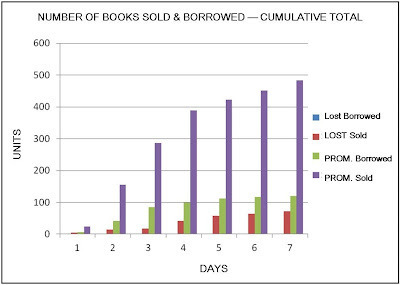 I also wondered if this campaign would boost sales of my Seeds of Christianity Series. I believe I'm seeing an indication of this. So far, combined April sales for the Seeds Series are over twice the first quarter's average monthly sales. This may be because we include a link list in each eBook to all my other eBooks. If you haven’t done this, you definitely should.
I also wondered if this campaign would boost sales of my Seeds of Christianity Series. I believe I'm seeing an indication of this. So far, combined April sales for the Seeds Series are over twice the first quarter's average monthly sales. This may be because we include a link list in each eBook to all my other eBooks. If you haven’t done this, you definitely should.PLANNING YOUR CAMPAIGNIf you enroll one or more of your books in KDP Select, the first thing you’ll have to do is un-publish them everywhere else. This is a good time to make a critical examination of your cover art. Maybe you can’t tell a book by its cover, but a good cover sells books. Don’t make a change if there is a companion print edition; the covers should match. You may also want to revisit your pricing. The eBook market follows the high volume-low margin model.
Now it’s time to lock in some days. The first piece of advice I got was promote early in the week because Friday and the Weekend are prime selling days. I did a two-day promo on Wednesday and Thursday. Had I gone three days, I would’ve added Tuesday not Friday. Another suggestion I found was to book your days individually rather than as a block. That way, if the promo opens on a Tuesday and belly flops, you can easily cancel the other days. The other advantage to this strategy is, you can instantly extend it another day if things are going good.
Booking individual days is a good idea, but a study of my graphs shows PROMISES started slow and gradually built momentum. Why? Did a competing book hold it back at first? Does it take time for readers to become aware of your title? Was it influenced by the timing of tweets and posts? There’s no way to know. Interestingly, I sent my son an email on Tuesday afternoon saying I expected to move about 5,000 copies. When I checked the following morning, we had over 11,000 downloads. The moral here is, don’t be too quick to pull the plug. The graphs seem to say that once you earn a high ranking, the momentum is somewhat self-sustaining. You’re king of the hill and it’s up to someone else to knock you off, or wait until your campaign ends.
LOOKING TO THE FUTUREThere are a couple of points I’d like to elaborate on. Being human, we have a tendency to wonder How long can this last? What happens when everybody’s bought one of my books? Don’t worry about it. Last Christmas Amazon was selling Kindles at the rate of over 1,000,000 a week. For the time being they’re adding potential customers faster than most of us can sell books. Will there be a time when the market reaches saturation? Of course, but no time soon.
Much has been written about digital books leveling the playing field between indie authors, small publishers, and The Big Seven. And, to some extent, it has proven out. However, coming from a Corporate Planning/Financial Analytic background, I’ve had a niggling fear that some number-cruncher at Amazon will someday say, “My research shows that unless a Kindle book sells X copies, we’re better off without it. Too many of these self-published books just languish in the catalog, clogging our server capacity.” Ouch! Good-bye indie authors and small publishers. Here come the heavy hitters. The way to avoid this happening to you is to make sure you’re on the up side of the sales curve. Financial considerations aside, you can’t sell out of an empty wagon. First and foremost, as an author you must do everything possible to insure that your books are readily available. A couple of successful Kindle promotions provides some insurance.
When thanking everyone who helped, I failed to mention Amazon. It’s easy to grow cynical and say, “What did they do? They’re already the elephant in the living room. I mean, it doesn’t cost anything to give away a digital book, does it?” Well, actually, it does. Bytes cost money. I don’t claim to know how much, but you can’t send them flying across the world for free. Those familiar with Kindle publishing know that Amazon, like any merchant, takes a margin on each sale. (They, of course, forego this on the free copies.) They also charge a download fee based on the file size of the book. The digital download fee isn’t much, but it is there. They charge a six cent fee on every copy of PROMISES. If my math is correct, that means those 21,200 free copies they downloaded represented $1271.40. So they put something in the pot too. Thank you, Amazon.com.
UNANSWERED QUESTIONSCareful study of the accumulative sales graph shows that, while I met my sales goals, the number of sales per day dropped on Monday, day 4, and declined each day thereafter. Was this because there’s less activity during the week? Will sales rebound this coming weekend? Or is this the end of the tail (tale)? Will there be any long-term affects on sales? Tantalizing as they may be to speculate, it’s too soon to answer any of these questions. However, I will be monitoring sales of LOST for the next few weeks. As people complete PROMISES, they'll be exposed to the promo for LOST. Seeing a secondary upward trend in sales would be interesting. Regardless, most companies advertise their products continuously. PROMISES has three additional free days in the current 90-day period. LOST has five. And I intend to use ‘em.
One last point—checking your Kindle sales data more often won’t make the numbers go up any faster.
If you’re contemplating an Amazon free promotion, or have other related marketing issues you’d like to address, you can include it in a comment. I’d also be happy to continue this conversation on a one-to-one basis if you prefer. My email address is in my profile.
Sites Advertising Free Kindle Promotions (No Particular Order)
All Things Kindle (FaceBook) Pixel of Ink
Kindle Boards (under Book Bazaar)
Digital Book Today
World Literary Café
Free Ebook Deal (FaceBook)
Free Kindle Books & Tips (FaceBook)
Christian Specific Sites:Inspired Reads
Family Fiction
Christian Books by Indie Authors (FaceBook)
Christian Fiction Gathering (FaceBook)
A detailed search will surely turn up additional sites willing to plug your promotion. Also be sure to create an event on GoodReads, do FaceBook posts, and mention it on your Blog.
Next Tuesday we’ll take a look at the legacy of Boadicea’s Revolt on Britannia. Specifically we examine its effect on the Roman capitol of Camulodunum, present day Colchester.
Until then, we wish you Peace and Blessings
Published on April 20, 2012 01:00
April 18, 2012
ROMAN STONE SHIPS, BARGES, OBELISKS & COLUMNS
 Divers Used Floatation Balloons to Raise Column Drums from the Sunken Ship
Divers Used Floatation Balloons to Raise Column Drums from the Sunken ShipHello My Friend and Welcome.
Among other things, today we’re going to talk about obelisks…those stone pillars with a square base and a pointed top that the Egyptian Pharaohs loved so much. Think of the Washington Monument. In truth, the Washington Monument is not truly an obelisk, but an obelisk-shaped building. The difference being that the obelisks the Egyptians made were carved from a single piece of stone, whereas anyone who’s ever visited Washington, DC knows you can go up inside the Washington Monument.
GREAT FEATS OF ENGINEERING AND LOGISTICSBut, we’re getting off track. This post was prompted by a story about the recovery of a 1st Century BC Roman Stone Carrier discovered in waters off southeastern Turkey. The glorious monuments of Egypt, Greece and Rome are clearly architectural masterpieces, but they are also great feats of engineering and logistics.
The particular ship they found was carrying a column when it sank. It cargo consisted of eight marble column drums, each about five feet across, and a capital. Stacked one atop the other, the drums would have formed a 30-foot-high Doric column.
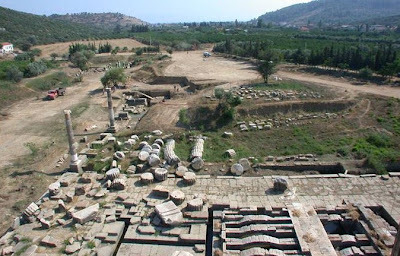 Ruins of the Temple of Apollo...Note Column Drums The ship foundered off Kızılburun (Crimson Cape), 40 miles from the Temple of Apollo at Claros, famous for an oracle similar to the one at Delphi. Based on detailed measurements and stylistic analysis, experts are certain the column was intended for Claros. Interestingly, the eight drums in the cargo, which weighed a total of about 50 tons, aren't enough for a single column at Claros. Those were composed of 11 or 12 drums. A ship like the one they found would have had to make 20 trips to supply enough marble for the 14 known columns at Claros. The drums were recovered using balloons to lift them from the sea floor. Marble headstones and basins were also found in the ship’s hull. They too, were probably bound for Claros.
Ruins of the Temple of Apollo...Note Column Drums The ship foundered off Kızılburun (Crimson Cape), 40 miles from the Temple of Apollo at Claros, famous for an oracle similar to the one at Delphi. Based on detailed measurements and stylistic analysis, experts are certain the column was intended for Claros. Interestingly, the eight drums in the cargo, which weighed a total of about 50 tons, aren't enough for a single column at Claros. Those were composed of 11 or 12 drums. A ship like the one they found would have had to make 20 trips to supply enough marble for the 14 known columns at Claros. The drums were recovered using balloons to lift them from the sea floor. Marble headstones and basins were also found in the ship’s hull. They too, were probably bound for Claros. DWARFED BY A BARGEBut the ship found off Turkey would have been dwarfed by the barge used to transport an obelisk from Egypt to Rome around 38 AD. The huge stone-carrier Caligula had built to transport the obelisk from Alexandria to Ostia was eventually sunk. Pliny the Elder described the sinking of this massive 800 ton ship. It formed the foundation for the lighthouse at the new and larger artificial harbor, Portus Cladius. Constructed north of Ostia between 42 and 62 AD, it was designed to handle the larger cargo ships that could not dock at Ostia, Rome’s original port.Remains of the barge, 340 feet long and 66 feet wide, were discovered during the construction of Rome's Leonardo da Vinci International Airport in Fiumicino, Italy. At one time Fiumicino was a Roman port north of Ostia at the mouth of the Tiber River.
Quarries in the Aswan region furnished the stone for most Egyptian monument, obelisks included. One source says the obelisk was quarried at Aswan during the reign of Amenemhet II in the 19th Century BC and erected at the Temple of the Sun in Heliopolis. Others think Octavian, known to us as the Emperor Augustus in Luke’s gospel, installed the obelisk in the Julian Forum in Alexandria. The obelisk is unusual because it lacks hieroglyphics. No one can say why. Perhaps an Egyptian Pharaoh suddenly died before it was completed, or it has none because a Roman Emperor ordered its construction.
Either way, Caligula transported it to Rome and erected it in the new Caligula Circus. He didn’t live long enough to see the projection completed. It was completed under Nero’s Reign and called Nero’s Circus. It was the sight of Peter’s crucifixion. Later renamed the Vatican Circus, it became the site of St. Peter's Cathedral erected by Constantine the Great over the great saint’s grave.
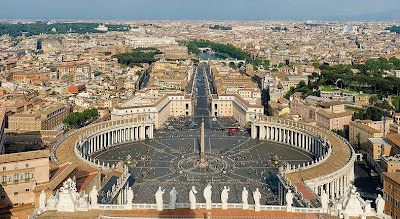 The Obelisk at the Center of St. Peter's Square THE CENTER OF ST. PETER’S SQUAREPope Sixtus V had the obelisk moved to the center of the colonnaded square in 1586 during the construction of the new, or current, St. Peter’s Basilica. It remains there today. All of the obelisks in Rome were toppled in the Middle Ages except for this one. Innumerable Christians, including St. Peter, died in the Vatican Circus. Consequently, it was left standing as the last mute witness to the martyrdom of St. Peter.
The Obelisk at the Center of St. Peter's Square THE CENTER OF ST. PETER’S SQUAREPope Sixtus V had the obelisk moved to the center of the colonnaded square in 1586 during the construction of the new, or current, St. Peter’s Basilica. It remains there today. All of the obelisks in Rome were toppled in the Middle Ages except for this one. Innumerable Christians, including St. Peter, died in the Vatican Circus. Consequently, it was left standing as the last mute witness to the martyrdom of St. Peter.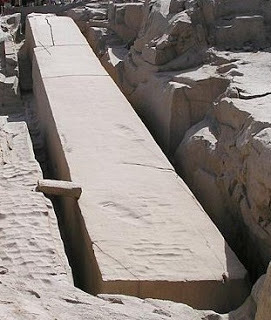 Plans Run Amok - The Cracked Obelisk A SAD END TO GREAT PLANSOne final point before we leave obelisks. The photo above shows the Aswan Obelisk. This unfinished piece was carved from the rock, but never completely detached because it cracked. This is always a risk when quarrying. As layers are removed, the pressures on the freshly exposed rock change, causing different parts to expand at different rates. Sometimes the rock cracks, rendering it useless.
Plans Run Amok - The Cracked Obelisk A SAD END TO GREAT PLANSOne final point before we leave obelisks. The photo above shows the Aswan Obelisk. This unfinished piece was carved from the rock, but never completely detached because it cracked. This is always a risk when quarrying. As layers are removed, the pressures on the freshly exposed rock change, causing different parts to expand at different rates. Sometimes the rock cracks, rendering it useless. 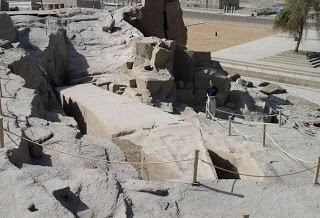
On close examination, one can still see pits made by the hammer stones used to shape it. Wet sand and sandstone would eventually have been used to burnish the surface. This obelisk, if it had been successfully detached would have weighed more than a thousand tons, three to six times as much as they typically did. Perhaps that is why it cracked. What it was intended for is not known.
Next time we’ll have our monthly contribution to the Christian Writer’s Blog Chain. The following Tuesday, we visit the real King Solomon’s Mines.
Until then, we wish you Peace and Blessings.
If you reached this post via a link, click the HOME tab above to see other recent posts and visit our archives.
Published on April 18, 2012 01:00
April 16, 2012
ANCIENT GAMES - CALCULI
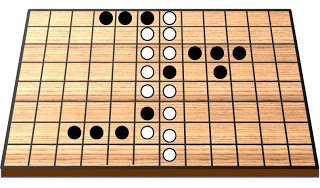 A Game of Calculi in Progress
A Game of Calculi in ProgressHello My Friend and Welcome.
Today we extended our study of the Games People Played in the First Century with the Roman game of Five-in-a-Row, often referred to as Calculi. Just as the attack game of Latrunculi is often called Roman Chess, people sometimes refer to Calculi as Roman checkers. This is done, in part, to differentiate it from Latrunculi. Just as checkers is chess’ kinder, gentler cousin, Calculi similarly lacks the war-like strategy of Latrunculi. If you missed the previous posts in this series, you can find Latrunculi HERE, and Hounds and Jackals HERE.
POPULARITY OF ANCIENT BOARD GAMESIn a world without iPods, Game Boys, X-Boxes, Cable TV and all of the other electronic distractions of 21st Century life, women as well as men played board games.
Pliny mentions Ummidia Quadratilla in his letters. The grandmother of one of his friends, she lived to be eighty and amused herself playing ludus calculorum, or games of stones. Nearly all board games of the era employed polished stones or glass discs as game pieces, so it remains unclear which of them she preferred.
Another Roman writer, Martial, says, “A tavern-keeper, a butcher, a bath, a barber, and a game board with stones, and a few books... warrant these to me, Rufus, and keep to yourself Nero's warm baths.”
THE GAME KNOWN AS CALCULIAs we learned from Pliny, ludus calculorum was a catch-all term. Calculi is a term that has come to be used for specific games of stones in which the object is to arrange five of your playing pieces in a vertical, horizontal or diagonal row. This prevents the game from being confused with other games that also utilized stone game pieces such as Latrunculi, Duodecim Scripa, and Tabula, among others.
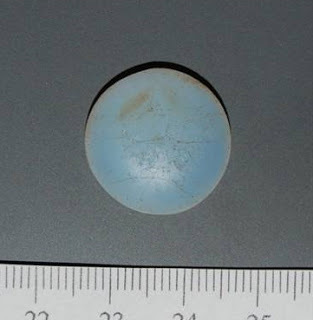 Ancient Glass Playing Piece The ancient Greeks also played a similar game that required players to align five gaming pieces. While Calculi can be played on the Latrunculi board of 8 x 8 squares, something larger…say 8 x 12, allows for more flexibility and strategy. Calculi also requires more playing pieces than Latrunculi. Particularly when the size of the board increases since there will be more blocked attempts.
Ancient Glass Playing Piece The ancient Greeks also played a similar game that required players to align five gaming pieces. While Calculi can be played on the Latrunculi board of 8 x 8 squares, something larger…say 8 x 12, allows for more flexibility and strategy. Calculi also requires more playing pieces than Latrunculi. Particularly when the size of the board increases since there will be more blocked attempts. HOW THE GAME IS PLAYEDThe rules of Calculi are rather simple. 1. Players each have an unlimited number of playing pieces.
2. Black usually starts the game.
3. The first person to make a vertical, horizontal, or diagonal line of five playing pieces wins.
4. If the board becomes filled, the game is a draw.

There is a qualifying restriction. A double open-ended row of three is illegal unless a player is forced to make the play. This refers to a row of three that simultaneously goes in two directions, forming a cross, an X or a T. Once constructed, such an alignment makes for an easy win.
This rule leads to a strategy in which players try to combine a line of three with a line of four. Then, if the opposing player moves to block the row of four — which they must do to prevent a win their opponent adds to the row of three, making it four. No matter which end of the row their opponent blocks, adding a piece to the opposite end now yields a win.

A standard checker board is an easy way to get a taste of Calculi. Keep in mind, additional checkers will be required, or something like pennies or poker chips can be substituted. Lacking that, the modern game of Connect Four makes an acceptable substitute.
Next time we’ll examine the some of the largest ships of the ancient world - the Roman Stone Carriers.
Until then, we wish you Peace and Blessings.
If you reached this post via a link, click the HOME tab above to see other posts and our archives.
Published on April 16, 2012 01:00



